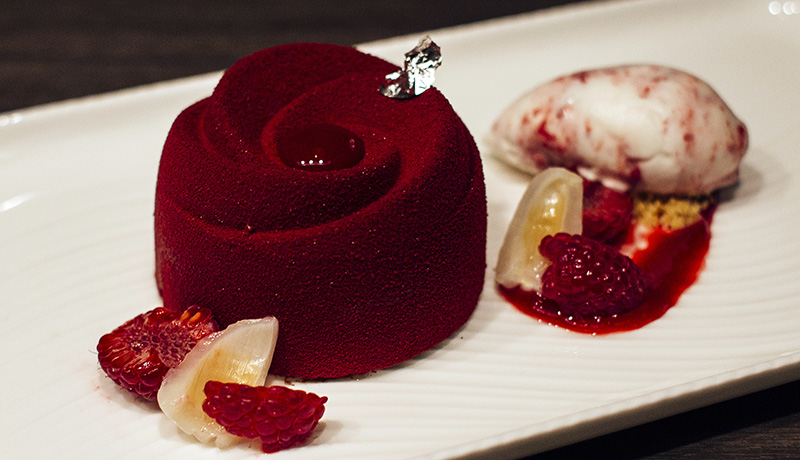

Oahu’s Newest Gastronomic Wonder, Photo Credit: Yauatcha Waikiki
Sun, sand and surf may be the top priorities for most visitors who escape to the island of Oahu, but in recent years, Honolulu has increasingly become regarded as a gastronomic destination as much as a beach one.
From contemporary takes on Hawaiian cuisine at spots like chef Ed Kenney’s Mud Hen Water to exclusive, six-person omakase sushi bars like Sushi Sho at The Ritz-Carlton Residences Waikiki Beach, not to mention a thriving Japanese food presence that has spawned entire food alleys like Shirokiya Japan Village Walk at the Ala Moana Center, Honolulu is a fantastic locale to indulge your palate.
Which is why, when Hakkasan Group decided to bring Yauatcha to the U.S., Honolulu was an ideal choice. Debuting in February in the newly re-imagined International Market Place in the heart of Waikiki, Yauatcha Waikiki (pronounced “Yah-WAH-chah”) brings the critically acclaimed dim sum tea house and patisserie that originated in London’s Soho to Hawaii. The Waikiki location is the first of two in the U.S., with a second set to open in Houston later this spring.
Prominently situated on the Grand Lanai of the International Market Place, where it keeps company with celebrity-chef-helmed spots such as Michael Mina’s Stripsteak Waikiki and Roy Yamaguchi’s Eating House 1849, Yauatcha offers you world-class dim sum and phenomenal pastries in a sleek, contemporary setting.
The menu at Yauatcha Waikiki is unique to the islands in that several of the dishes incorporate local ingredients. Executive chef Ho Chee Boon, who oversees all of the Asian concepts for Hakkasan Group, made several trips to Hawaii prior to the opening to source area herbs and produce.

Phoenix tail shrimp shui mai, Photo Credit: Yauatcha Waikiki
“All the vegetables here [in Hawaii] are so good,” Boon says. “The morning glory, the taro, the Shanghai bok choy, the local melon — all of these are on our menu. You will find them in dishes that are local to Hawaii only. For instance, the crab and taro croquette uses local taro. The Kona kanpachi fish entrée uses amberjack that is local to the islands.”
In addition to these selections, Yauatcha’s signature dishes — available at all Yauatcha locations worldwide (two in London, four in India and one coming to Saudi Arabia in 2018) — are items that Boon says you can’t find in any other Chinese restaurant. “There are so many dishes,” he says, “but the most popular, are the venison puff, the prawn and crispy bean curd cheung fun, the scallop shui mai and the Phoenix tail shrimp shui mai.”
While the à la carte menu lets you pick and choose whichever items you fancy, those who want to see what Yauatcha really has to offer can order one of three pre-set tasting menus. The curated menus are served family style so that you can sample through menu highlights, including steamed dumplings, fried delicacies, noodles, vegetables, crispy aromatic duck and, of course, desserts.
Speaking of after-dinner treats, Yauatcha’s delectable lineup of pastries is not to be overlooked. Overseen by London-based pastry chef Graham Hornigold, the petits gateaux (little cakes), French macarons and housemade chocolates are not only scrumptious, but so Instagram-worthy, you could plan a visit just for the photogenic sweets alone.
Must-try desserts include the raspberry delice, which is fashioned to looked like a deep-red-colored rose and is filled with chocolate mousse. Also noteworthy is the new tropical dome, a yellow gelée-glazed mousse cake made with local coconut dacquoise, lililko’i (passionfruit) and pineapple, which Hornigold created to capture the flavor of the islands.

Raspberry delice, Photo Credit: Yauatcha Waikiki
On the design front, Paris-based interior design firm GBRH, which is also responsible for the décor at the original Yauatcha in Soho, has created a space that is Asian in theme, yet in vogue with modern aesthetics. Feng-shui-approved colors are utilized in harmonious balance. Yauatcha’s signature symbol, the clover, is also woven subtlety throughout the 8,600-square-foot space, where it is carved into the back of bar stools and used as a frame for the trademark blue-glass windows.
Indoor seating gives you a glimpse into the open kitchen, where white-clad chefs and stacks of bamboo steamer trays can be seen through a constant haze of billowing vapor.
Meanwhile, the restaurant’s bar adjoins the interior with an expansive terrace, where you can enjoy Honolulu’s fantastic weather and marvel at the giant 100-year-old banyan tree anchored in the center of the International Market Place complex.
